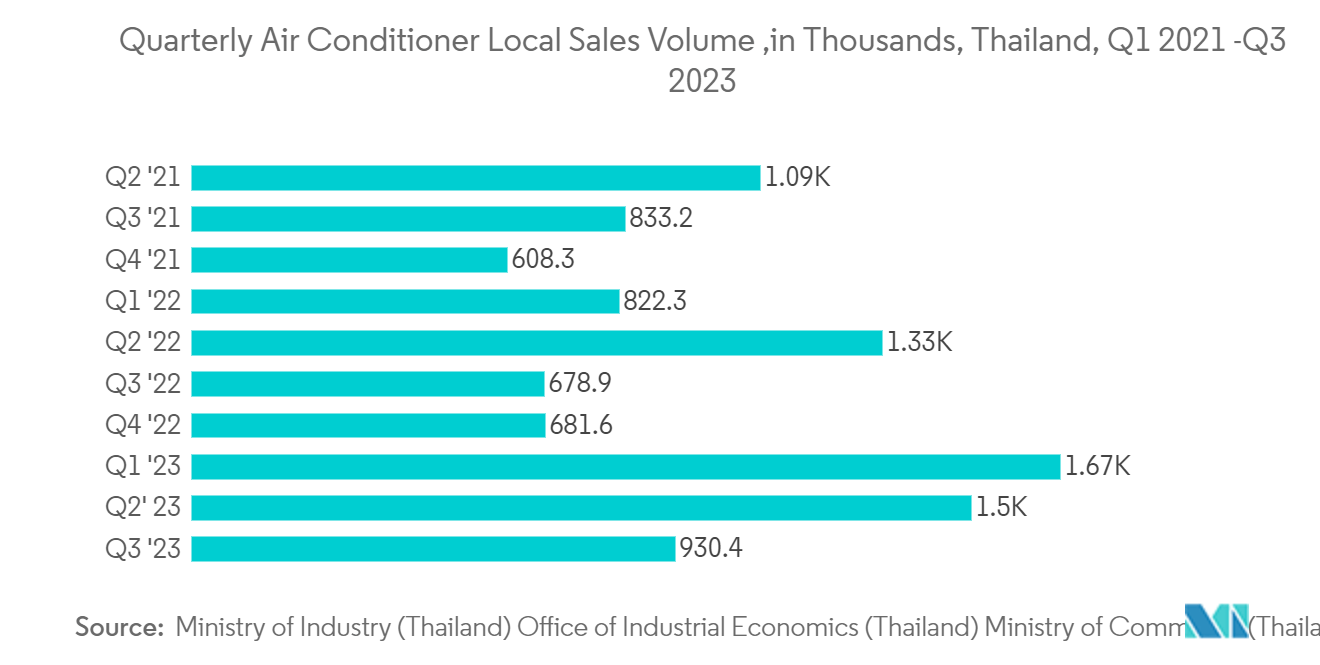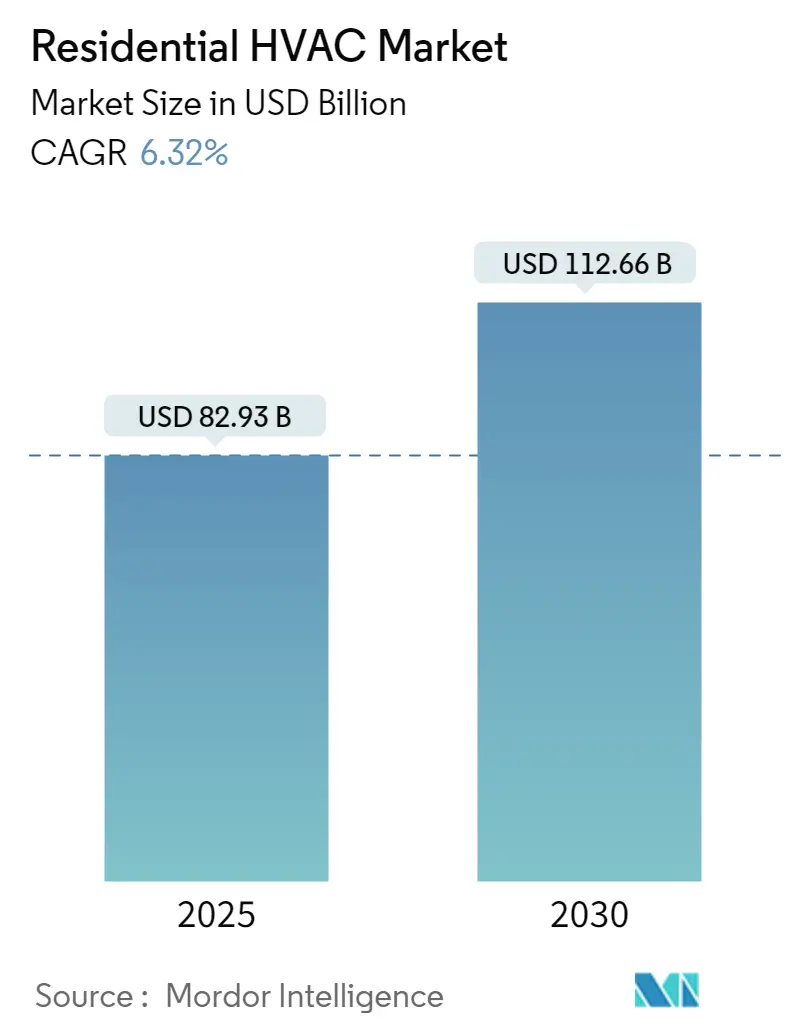
| Study Period | 2019 - 2030 |
| Market Size (2025) | USD 82.93 Billion |
| Market Size (2030) | USD 112.66 Billion |
| CAGR (2025 - 2030) | 6.32 % |
| Fastest Growing Market | Asia Pacific |
| Largest Market | North America |
| Market Concentration | Medium |
Major Players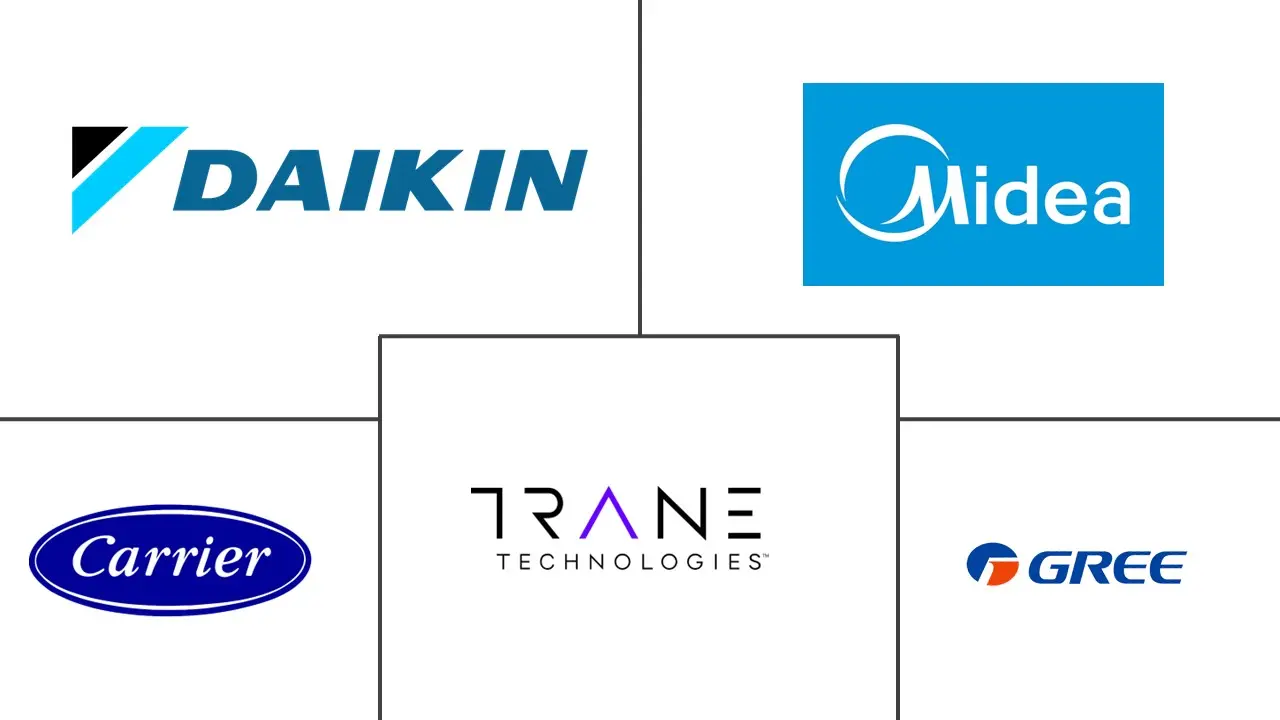
*Disclaimer: Major Players sorted in no particular order |
Residential HVAC Market Analysis
The Residential HVAC Market size is estimated at USD 82.93 billion in 2025, and is expected to reach USD 112.66 billion by 2030, at a CAGR of 6.32% during the forecast period (2025-2030).
The market growth is attributed to the growing demand for energy-efficient and smart HVAC systems, the growing urban population, changing climate conditions, and advanced HVAC systems with cutting-edge technologies.
- Air conditioners, including window units and through-the-wall, are gaining momentum in hot and high-income countries with the growing temperatures and increasing consumer spending. The increasing shipments of air conditioners worldwide accelerate the market growth.
- The growing need for space and water heating drives the adoption of heat pumps in cold regions. Further, the increased government incentives and policy support for heat pumps amid high natural gas prices and efforts to reduce greenhouse gas emissions fuel the adoption of heat pumps. For instance, according to IEA, in 2022, the global sales of heat pumps increased by 11% compared to the previous year. In Europe, the sales of heat pumps increased by around 40% compared to the previous year, reaching around 3 million units.
- In recent years, HVAC manufacturers have been focusing on developing smart equipment with the integration of cutting-edge technologies such as AI, Analytics, and automation developed to improve their market position and stay competitive. For instance, in February 2023, Hisense launched smart air conditioners in India - IntelliPro and CoolingXpert. The new air conditioners offer a variety of features, including a 5-in-1 Convertible Pro, a WIFI Voice Control, and others. Also, it includes a sleep mode and automatically changes the temperature, which helps to save energy usage up to 36%.
- Russia and Ukraine's war had a major impact on natural gas and electricity; the prices increased exponentially, encouraging consumers to switch to other more efficient heating options, such as heat pumps. In response to high prices for natural gas and the government export/import ban imposed on Russia, European Commission planned to double the installation of heat pumps to reduce the reliance on Russia for Natural gas. Most of the European Union countries are also incentives to make this target achievable.
- The COVID-19 pandemic severely impacted the whole global supply chain, causing a shortage of raw materials, increased delivery time, and suspended production for a short period. The demand for air ventilators increased due to keeping the air clean and pure. The HVAC system modifications helped reduce the spread of the coronavirus by improving ventilation, purifying air, and managing airflows in rooms. According to Ensavior, the HVAC systems provider state,d the demand for high-quality air filtration systems increased during the COVID-19 pandemic as consumers wanted clean air.
Residential HVAC Market Trends
Air Conditioning/Ventilation Segment to Hold Significant Market Share
- Air conditioning and ventilation systems are expected to hold a significant share of the global HVAC market. These systems help to maintain indoor air quality through filtration and ventilation. The growing air pollution and increasing virus spread across the globe creates demand for better air quality HVAC systems.
- According to the American Lung Association Report 2023, Ozone and particle pollution severely impact the functioning of the immune system and increase sensitivity to respiratory infections. As per the study conducted by the association in 2022, people living in the most polluted regions of California had a 51% higher risk of death and 20% higher risk of infection than people living in the least polluted areas.
- Rising consumer purchasing power and increasing disposable income, especially in developing economies, also positively impact the market. For instance, according to the National Bureau of Statistics of China, the average annual per capita disposable income of households in the country amounted to approximately CNY 36,883 (USD 5332.53 ) in 2022, significantly up from CNY 35,128 (USD 5078.80) during the previous year.
- With significant population growth, using HVAC systems is becoming increasingly common. For instance, air conditioners and electric fans already account for around a fifth of the total electricity in buildings globally, or 10% of all global electricity consumption (according to IEA).
- The major market players are focusing on developing advanced air conditioning and ventilation systems with advanced air filters. For instance, Daikin Europe launched its new Modular T series air handling unit with three separate filtration stages in August 2022. Daikin's Modular T AHU filters outside air for removing external pollutants before suppling and simultaneously extracts inside air, thereby decreasing the concentration of indoor pollutants to ensure a constant supply of healthy fresh air. The new units would be launched in five different sizes and an airflow range from 200m3/h up to more than 4,000m3/h.
North America to Hold Significant Market Share
- North America is projected to hold a significant share of the HVAC market owing to the government's increasing budgetary support for sustainable community development may be a factor in expanding the adoption of energy-efficient HVAC systems. Additionally, the rise in polluted air and accelerated urbanization increase demand for the country's heating, air conditioning, and ventilation systems.
- The American government also provides incentives to encourage energy efficiency or the use of renewable resources. The U.S. government's rules put in place to monitor HVAC system performance in response to growing worries about global warming will be a critical factor in increasing demand. For instance, tax credits are provided for energy-efficient items, ranging from 20 to 30 percent of the installation cost. The installation of HVAC systems will rise as a result of this.
- Moreover, the Building Technologies Office (BTO) of the U.S. Department of Energy (DOE) has established critical energy-saving goals of 24% by 2030. As a result of these restrictions, HVAC system suppliers, including those who provide HVAC systems, are investing in upgrading their equipment to comply with building automation system (BAS) integration protocols.
- In addition, the critical HVAC market companies have been raising their R&D expenditures in search of novel, innovative technology solutions predicted to drive market growth. For instance, Carrier announced the release of a 40MBAB heat pump air handler to address North America's expanding need for high-efficiency heat pumps in July 2022.
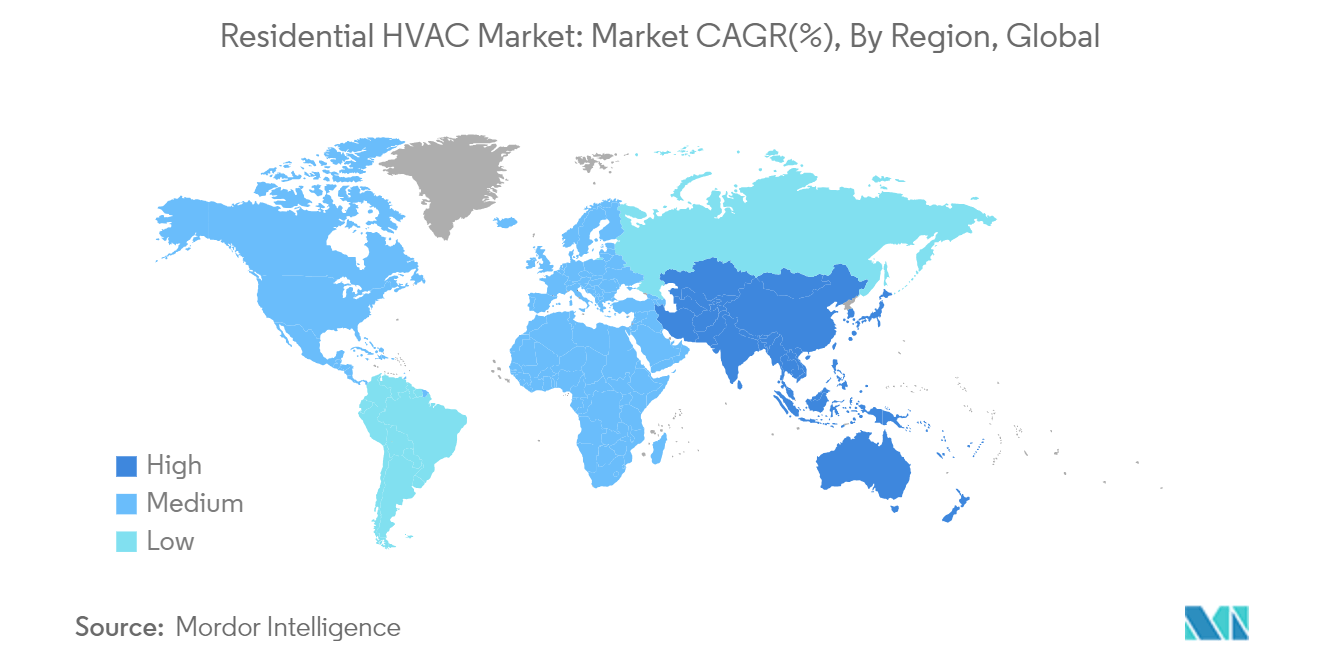
Residential HVAC Industry Overview
The Residential HVAC Market appears semi-consolidated, with large vendors such as Daikin Industries Ltd., Carrier Corporation, Robert Bosch, Mitsubishi Electric, and Johnson Controls. With growing urbanization, a shift in consumer preferences, and demand for energy-efficient systems increased the investment in the market. The major market players offer advanced and smart HVAC systems and rapidly indulge in mergers and acquisitions to increase the consumer base and product offerings.
- January 2023 - Johnson Controls-Hitachi Air Conditioning announced the launch of the air365 Max designed with energy efficiency, seamless comfort, and workable features. The air365 Max will be available in Latin America, Southeast Asia, and the Middle East in January and later in Europe, New Zealand, Australia, North America, and other regions.
Residential HVAC Market Leaders
-
Daikin Industries Ltd
-
Midea Group
-
Gree Electric Appliances
-
Trane Technologies
-
Carrier
- *Disclaimer: Major Players sorted in no particular order
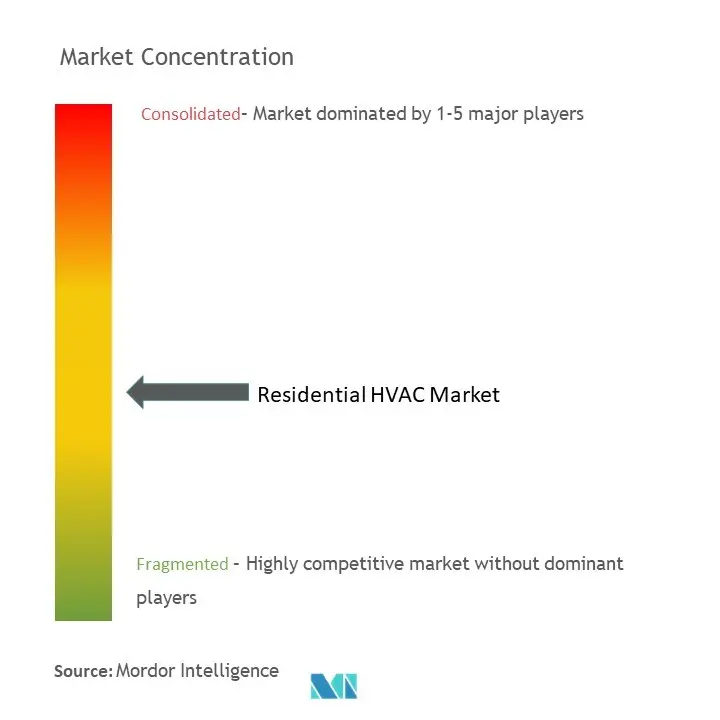
Residential HVAC Market News
- September 2023 - Johnson Controls-Hitachi Air Conditioning introduced the Hitachi air365 Hybrid dual fuel system, which combines a heat pump and furnace to provide efficient, economical home comfort year-round while reducing carbon emissions. The air365 Hybrid system features an electric Hitachi Mini VRF heat pump as the primary heating and cooling source and an innovative dual fuel module that attaches to a home's new or existing gas furnace.
- April 2023 - The Government of India announced a plan to increase renewable energy capacity by adding 70 GW annually for the next five years, aiming to achieve the goal of 500 GW by 2030. HVACs are in high demand in the area due to the country's numerous households installing modern air conditioning equipment to comply with laws and cut energy usage.
Residential HVAC Industry Segmentation
The residential heating, ventilation, and air conditioning (HVAC) systems are used for air handling and thermal comfort for residents. The market study covers heating, air conditioning, and ventilation equipment such as heat pumps, VRF, Single Splits and multi-splits, and air handling units.
The Residential HVAC market is segmented by equipment (air conditioning/ventilation equipment (type (single splits/multi splits(ducted/ductless), vrf, air handling units, other types [fan coils, rooftops, etc.])) and heating equipment (type (boilers/radiators/furnaces & other heaters, heat pumps)) and by geography (North America [United States, Canada], Europe [United Kingdom, Italy, Germany, France, Spain, Eastern Europe, Benelux, Nordics, Rest of Europe], Asia Pacific [China, India, Japan, Rest of Asia Pacific], Latin America, Middle East & Africa). The report offers the market size in value terms in USD for all the abovementioned segments.
| By Equipment | Air Conditioning/Ventilation Equipment | Type | Single splits/ multi splits (Ducted and Ductless) | |
| VRF | ||||
| Air Handling Units | ||||
| Other Types (Rooftops, Fan Coils, etc.) | ||||
| Heating Equipment | Type | Boilers/radiators/Furnaces & Other Heaters | ||
| Heat Pumps | ||||
| By Geography | North America | United States | ||
| Canada | ||||
| Europe | United Kingdom | |||
| Germany | ||||
| Italy | ||||
| France | ||||
| Eastern Europe | ||||
| Spain | ||||
| Benelux | ||||
| Nordics | ||||
| Rest of Europe | ||||
| Asia Pacific | China | |||
| India | ||||
| Japan | ||||
| Rest of Asia Pacific | ||||
| Latin America | ||||
| Middle East and Africa | ||||
Residential HVAC Market Research Faqs
How big is the Residential HVAC Market?
The Residential HVAC Market size is expected to reach USD 82.93 billion in 2025 and grow at a CAGR of 6.32% to reach USD 112.66 billion by 2030.
What is the current Residential HVAC Market size?
In 2025, the Residential HVAC Market size is expected to reach USD 82.93 billion.
Who are the key players in Residential HVAC Market?
Daikin Industries Ltd, Midea Group, Gree Electric Appliances, Trane Technologies and Carrier are the major companies operating in the Residential HVAC Market.
Which is the fastest growing region in Residential HVAC Market?
Asia Pacific is estimated to grow at the highest CAGR over the forecast period (2025-2030).
Which region has the biggest share in Residential HVAC Market?
In 2025, the North America accounts for the largest market share in Residential HVAC Market.
What years does this Residential HVAC Market cover, and what was the market size in 2024?
In 2024, the Residential HVAC Market size was estimated at USD 77.69 billion. The report covers the Residential HVAC Market historical market size for years: 2019, 2020, 2021, 2022, 2023 and 2024. The report also forecasts the Residential HVAC Market size for years: 2025, 2026, 2027, 2028, 2029 and 2030.
Our Best Selling Reports
Residential HVAC Industry Report
Statistics for the 2025 Residential HVAC market share, size and revenue growth rate, created by Mordor Intelligence™ Industry Reports. Residential HVAC analysis includes a market forecast outlook for 2025 to 2030 and historical overview. Get a sample of this industry analysis as a free report PDF download.



